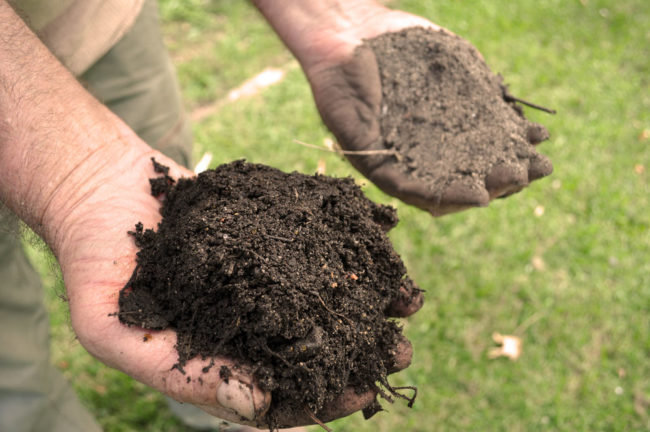Secrets of loose and fertile soil

The type and composition of soils directly affect the quality and quantity of the resulting crop, ornamental plants, and their health. To make the soil loose and fertile, you need to annually feed and mulch the beds during the growing season. But first it is necessary to determine what kind of soil composition in the garden. This will help to accurately select the type of nutrient mixes, mulch, and then turn the heavy soil into soft.
The need to determine the type, composition of soil

The fertility of the soil is a guarantee of good growth, good health of plants, from which it will be possible to harvest good crops in the future or, in the case of decorative plants, to get lush flowering, thick greens. Fertilizers, protruding with baking powder, will help to enrich the soil, make it air- and water-permeable. To choose the right type of the latter, you need to determine the type of soil, its composition. There are two ways to solve the problem:
- Take some land to the agrolaboratory.
- Independently study the mechanical structure.

The first method gives an unmistakable result, but it is not available everywhere and expensive. The second one will not answer questions about the deficiency or excess of nutrient macro-, microelements, but it will allow to determine the structure of the soil. The earth is moistened with water, they mold a ball out of it. If the figure crumbles, the soil is light, if you manage to form a kind of cord, even “twist it into a ring” is heavy.
How and how to improve the friability, fertility of heavy soil
To ensure air and water permeable soil structure using organic matter. It is more affordable not only for the price: you can prepare it yourself, compost manure in the presence of animals, sow green fertilizers, make a mulch from mowed grass.
Sand
Natural baking powder. To improve the structure of the soil make a coarse-grained river sand at the rate of 20 kg per 1 m2 of loam. It is distributed evenly over the surface of the beds, and then dug up to the depth of the spade bayonet, which is 20-25 cm. If the soil is alkaline, you can add peat. The latter sour the earth - use it with caution.
If the soil is infertile, additional humus is added, since a high content of sand will make the land even poorer.
Siderata

Green fertilizer is an important component for improving and maintaining the friability and fertility of the earth. Supporters of organic farming provide these indicators by sowing sideratov. The latter are legumes (lupine, vetch, pea, alfalfa). On their powerful roots are nodule bacteria that concentrate nitrogen, capturing and binding it from the air. Thanks to the power of the root system, the soil is not only enriched with an important macronutrient, but becomes loose: well aerated.
Organic matter in the form of the vital activity results of farm animals is the source of all macroelements necessary for the development of plants: nitrogen, phosphorus, potassium. Manure returns fertility. In the garden mainly cow is used, because it is less aggressive, compared to pig, in which the nitrogen concentration is even higher. It is best to bring rotted manure at the rate of 2 kg / m2.This can be done in the fall under the digging, as well as before spring sowing.
Fresh manure contains a high concentration of nitrogen - it can burn plantings. Use it only during autumn preparation Soil for the next season (5 months before the field work), only experienced farmers.
Mowing grass for mulching

A type of slow fertilizer. On heavy soils, they are used from the beginning of summer to late autumn: when used in spring, the beds will warm up slowly and will not have time to dry for sowing. The goals that the gardener can achieve with this method:
- Give the beds looseness, softness.
- Save moisture by reducing evaporation.
- Ensure continuous feeding due to gradual decomposition.
Lay out the straw between the beds and in the near-stem circles of plants with a layer of 10 cm. As a rule, about 1 bale of straw is spent per 20 m2. Mulch must be left to spend the winter on the beds. Reception for loosening heavy soils is repeated constantly. The first results can be seen only in 3-4 years, depending on the state of the land.
Even with heavy ground in the garden, you can achieve high yields. The main thing is to constantly maintain the friability of soil structure and fertility.





